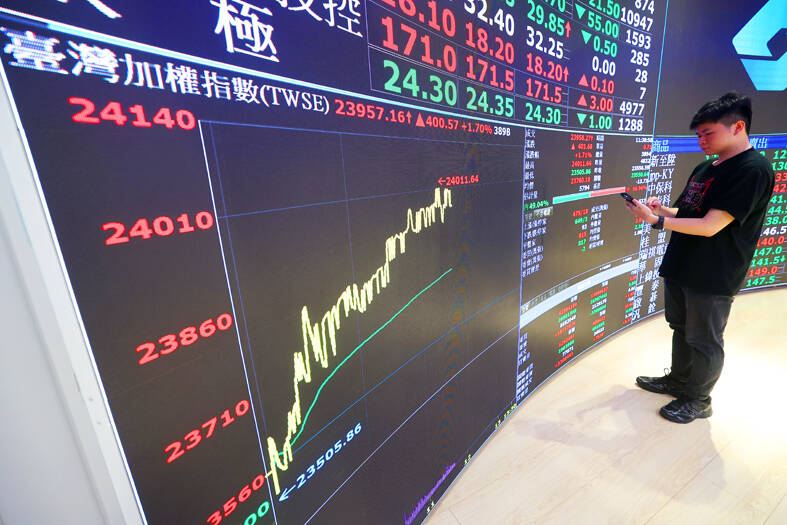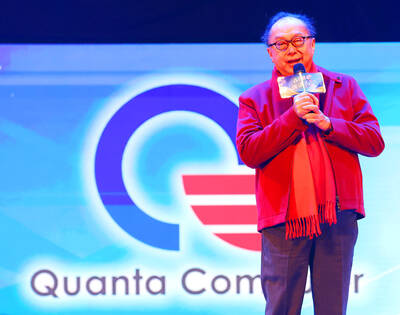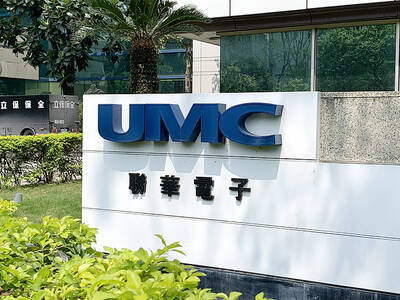The race to replace China’s top spot in emerging market equity portfolios is heating up, with Taiwan and India running neck and neck as formidable rivals.
Thanks to record stock rallies, Taiwan and India now command more than 19 percent weightings each in the MSCI EM Index. That compares with China’s 22.8 percent, whose standing has steadily shrunk over the past few years, Bloomberg-compiled data showed.
The rise of Taiwan and India is allowing investors to better diversify by betting on artificial intelligence (AI) chipmakers and the infrastructure boom coming from Indian Prime Minister Narendra Modi’s programs to modernize the country.

Photo: CNA
As the US rate cycle peaks out, having attractive options in emerging markets is fundamental to any pivoting of capital flows.
“Investors are seeking ways to manage the risk associated with China’s outsized weight in emerging markets by diversifying into other markets,” Straits Investment Holdings Pte Ltd fund manager Manish Bhargava said in Singapore.
“Taiwan’s technological prowess, particularly in the semiconductor industry, and India’s growing tech sector and digital economy make them attractive alternatives,” Bhargava added.
At its peak in 2020, China accounted for 40 percent of the MSCI EM Index, with investors attracted by thriving e-commerce to sales of expensive liquor. That heavy weightage cost money managers dearly, with trillions of dollars wiped out as Beijing embarked on regulatory crackdowns and went on a deleveraging campaign for its indebted property sector.
If recent trends hold, Taiwan or India might catch up with China’s standing in MSCI EM this year, marking a shift into a multipolar emerging markets world.
Taiwan’s ascent is all the more notable considering its market capitalization — at US$2.6 trillion — stands at less than a third of China’s. The TAIEX has risen 33 percent this year to become one of the best-performing major benchmarks, bolstered by gains in Nvidia Corp supplier Taiwan Semiconductor Manufacturing Co (台積電).
Meanwhile, India’s NIFTY 50 Index has advanced more than 12 percent this year, hitting a fresh high as Modi promised policy continuity.
That’s in contrast to the sluggishness in Chinese stocks. Benchmarks have barely gained for the year, highlighting an urgency for policymakers to unveil a road map to resolve woes like the property crisis.
Underscoring the trend, the number of EM Ex-China fund launches so far this year is just three short of last year’s annual record, data compiled by Bloomberg showed.
Earnings are a crucial factor behind the allocation preferences. The 12-month forward earnings estimates for the MSCI China Index have barely changed year to date, while those for Taiwan and India have increased by at least 13 percent each.
“EM ex-China looks solid from an earnings angle,” Bloomberg Intelligence quantitative strategist Kumar Gautam said. “The gap between China and EM ex-China earnings revision is at a historical high and China’s earnings revision is too slow to pick up.”
To be sure, valuations can put some brakes on the bullish sentiment. The TAIEX and NIFTY 50 both trade at about 20 times of forward estimated earnings, compared with MSCI China at a little above nine.
Still, money continues to support the shift.
Emerging Asia ex-China’s equity markets recorded net inflows of about US$9 billion since the start of last month, with South Korea, India and Taiwan among the top recipients, data compiled by Bloomberg showed.
Meanwhile, mainland China has seen outflows via the trading links with Hong Kong during the period.
“Tech is eating the world,” Abrdn PLC senior investment director Pruksa Iamthongthong said. “This only compounds with AI, and we see the real winners as Asian tech hardware and semiconductor supply chain names.”

Quanta Computer Inc (廣達) chairman Barry Lam (林百里) is expected to share his views about the artificial intelligence (AI) industry’s prospects during his speech at the company’s 37th anniversary ceremony, as AI servers have become a new growth engine for the equipment manufacturing service provider. Lam’s speech is much anticipated, as Quanta has risen as one of the world’s major AI server suppliers. The company reported a 30 percent year-on-year growth in consolidated revenue to NT$1.41 trillion (US$43.35 billion) last year, thanks to fast-growing demand for servers, especially those with AI capabilities. The company told investors in November last year that

United Microelectronics Corp (UMC, 聯電) forecast that its wafer shipments this quarter would grow up to 7 percent sequentially and the factory utilization rate would rise to 75 percent, indicating that customers did not alter their ordering behavior due to the US President Donald Trump’s capricious US tariff policies. However, the uncertainty about US tariffs has weighed on the chipmaker’s business visibility for the second half of this year, UMC chief financial officer Liu Chi-tung (劉啟東) said at an online earnings conference yesterday. “Although the escalating trade tensions and global tariff policies have increased uncertainty in the semiconductor industry, we have not

Intel Corp has named Tasha Chuang (莊蓓瑜) to lead Intel Taiwan in a bid to reinforce relations between the company and its Taiwanese partners. The appointment of Chuang as general manager for Intel Taiwan takes effect on Thursday, the firm said in a statement yesterday. Chuang is to lead her team in Taiwan to pursue product development and sales growth in an effort to reinforce the company’s ties with its partners and clients, Intel said. Chuang was previously in charge of managing Intel’s ties with leading Taiwanese PC brand Asustek Computer Inc (華碩), which included helping Asustek strengthen its global businesses, the company

Power supply and electronic components maker Delta Electronics Inc (台達電) yesterday said it plans to ship its new 1 megawatt charging systems for electric trucks and buses in the first half of next year at the earliest. The new charging piles, which deliver up to 1 megawatt of charging power, are designed for heavy-duty electric vehicles, and support a maximum current of 1,500 amperes and output of 1,250 volts, Delta said in a news release. “If everything goes smoothly, we could begin shipping those new charging systems as early as in the first half of next year,” a company official said. The new